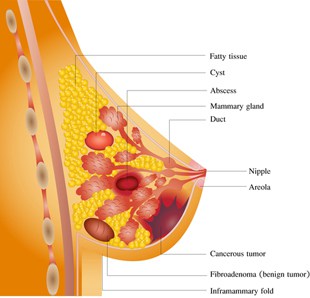Mammogram Fact Sheet
Mammograms are very effective screening tools for detecting breast cancer with the use of x-ray machines to locate tumors on the breasts. Older women are particularly at risk for developing breast cancer. By finding signs of cancer early on, mammograms can decrease the amount of breast-cancer-related deaths for women aged 40 to 70.
Overview of the Test
Women who suspect breast cancer because of a breast self-exam, or women with no symptoms benefit from mammograms. Screening mammograms use x-ray images to find tumors and microcalcifications that could indicate cancer in women who appear healthy.
Women who suspect they could have cancer because they or their physician has identified a lump, texture change or discharge from the breast or nipple can have a diagnostic mammogram. Doctors recommend these mammograms when there are signs of breast cancer. Unlike screening mammograms, diagnostic mammograms take longer and focus primarily on the area of the breast that is painful, thick or bumpy.
If either type of mammogram reveals tumors, they then need to be biopsied to determine if they are cancerous. Often time, lumps are harmless cysts or other growths, but without regular mammograms a cancerous tumor may not be found in time to prevent spreading of the disease.
Evidence and Science behind the Test
Studies on the effectiveness of mammograms as a screening tool for breast cancer are mainly positive. Evidence shows that screening mammograms can detect cancer in time to lower the risk of death in women age 40 and older. The same benefits have not been shown in studies on women under age 40.
How is it Done?
Mammograms are basically x-rays of breasts. A technician uses an x-ray machine set up for mammograms to get pictures of patient’s breasts that are then developed for an imaging physician to examine.
Women going in for a mammogram should avoid putting on deodorant or lotion on their breasts or armpits as this could show up as calcium spots on the test results, leading to a false positive. Before a test, technicians will ask if a woman has any signs of breast cancer.
During the test, a radiologic technologist places a woman’s breast into the machine one at a time. The breast rests on a platform and is then compressed. The gradual compression is necessary to see all of the tissue and ensure that nothing obstructs the machine’s view. The technician takes pictures from various angles and may ask the patient to change position. Both breasts go through the same process. It usually takes around 30 minutes to perform a screening mammogram. A diagnostic mammogram could take more time.
When and How Often?
How often not only depends on recommendations based on where a woman lives, but it also depends on their age, and if they have a higher risk of breast cancer (for example if they have a family history of breast cancer). Some recommend every one to two years for women age 40 or over and more frequently for those at risk. Generally, earlier and more frequent mammograms can identity early lesions.
Cost
Many insurance companies cover the cost of a mammogram. A small co-pay of around $10 to $35 may be all that someone pays. However, if a woman is uninsured or her insurance does not cover mammograms, she could pay anywhere from $80 to $212, or more, with prices varying by geographic region.
Issues
Mammograms are safe and use only a small amount of radiation. Concerns with mammograms are primarily that they can lead to false negatives and positives, which can lead to overtreatment. Around 20 percent of breast cancer instances are missed during a mammogram.
False positives are also possible and occur when a radiologist thinks that results are abnormal, but a patient does not actually have cancer. If a screening mammogram shows abnormal findings, a more thorough diagnostic mammogram, an ultrasound or a biopsy may be necessary to conclusively determine whether a woman has cancer. False positive are not common, but are more likely to occur in younger women, as well as women on estrogen medications, women with a family history and women who have undergone a breast biopsy.
References
- National Cancer Institute
- Medline Plus
- RadiologyInfo.org
- CostHelper
- Fast Living Slow Ageing; Kate Marie and Christopher Thomas; 2009
Last reviewed 26/Feb/2014







